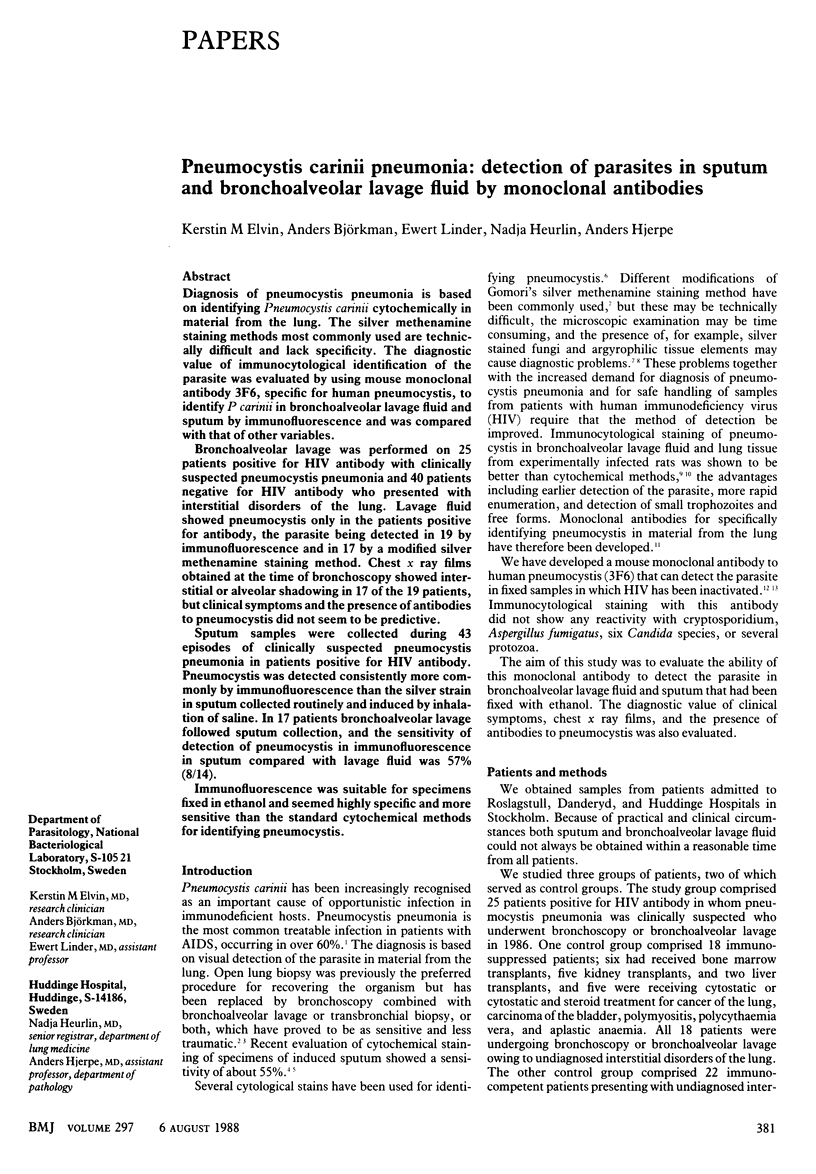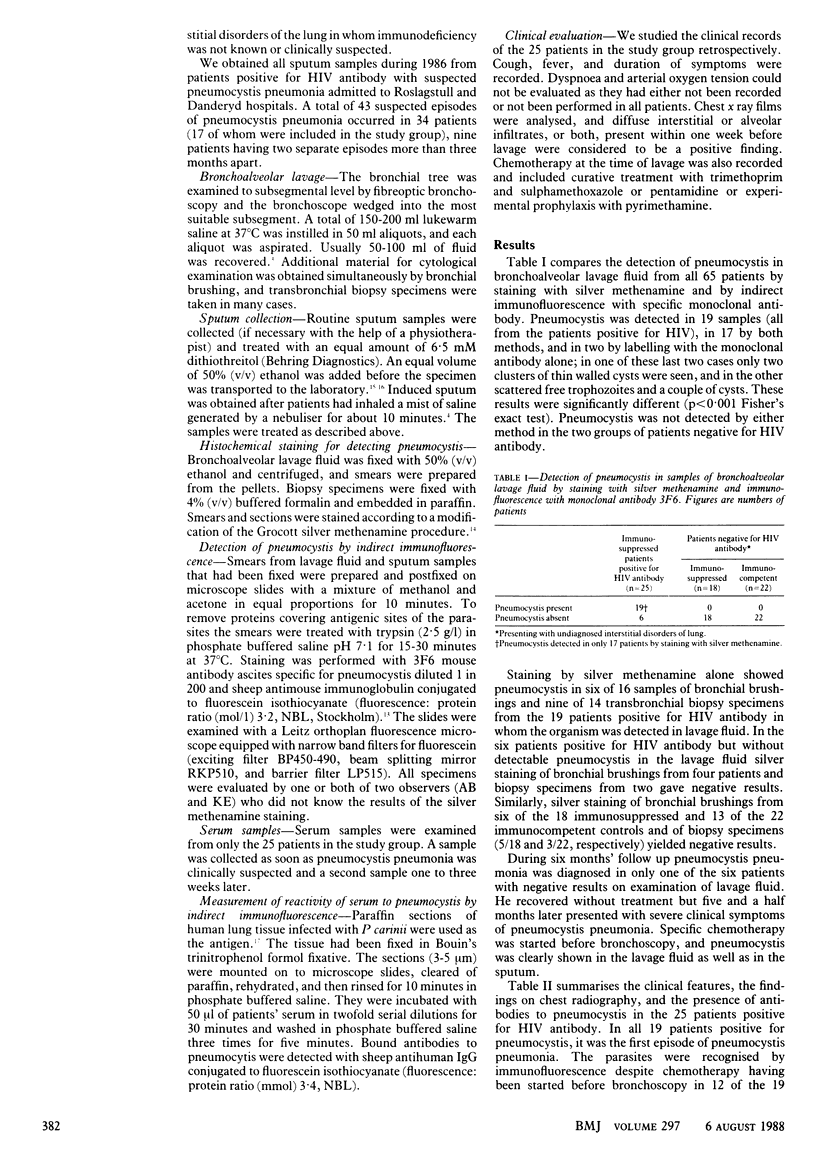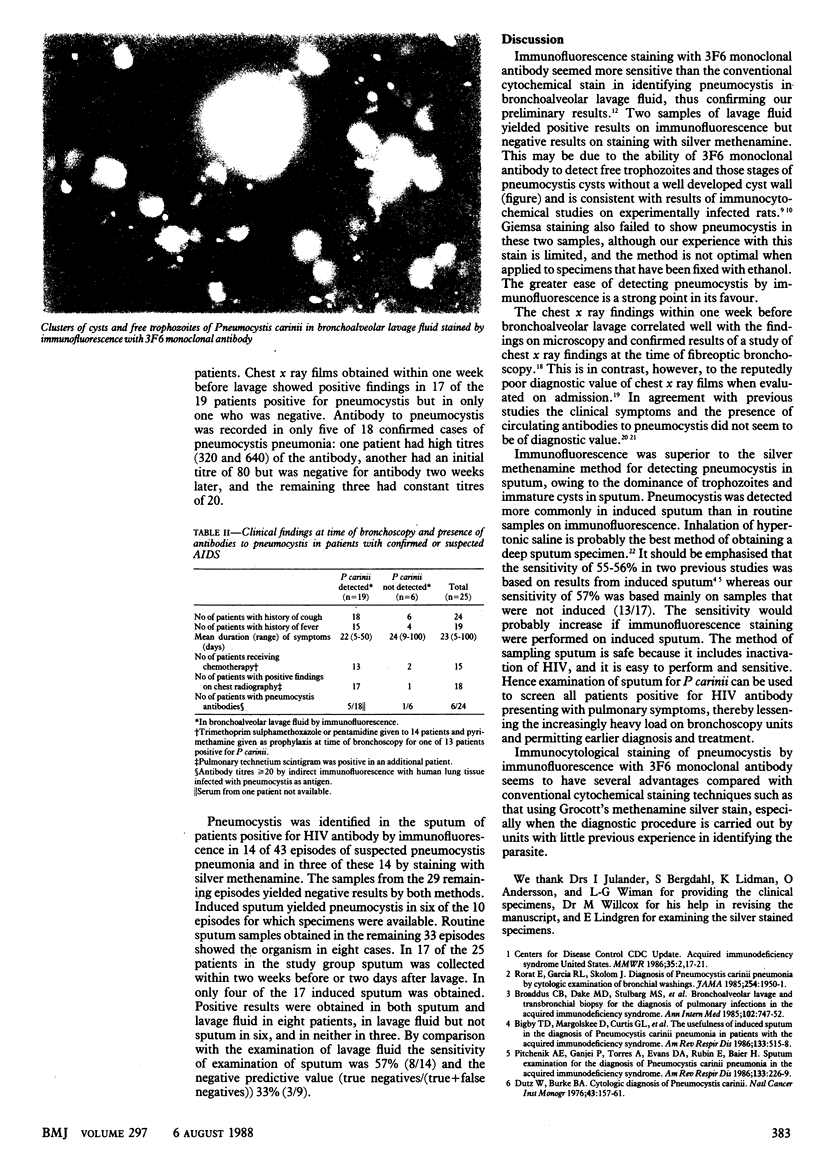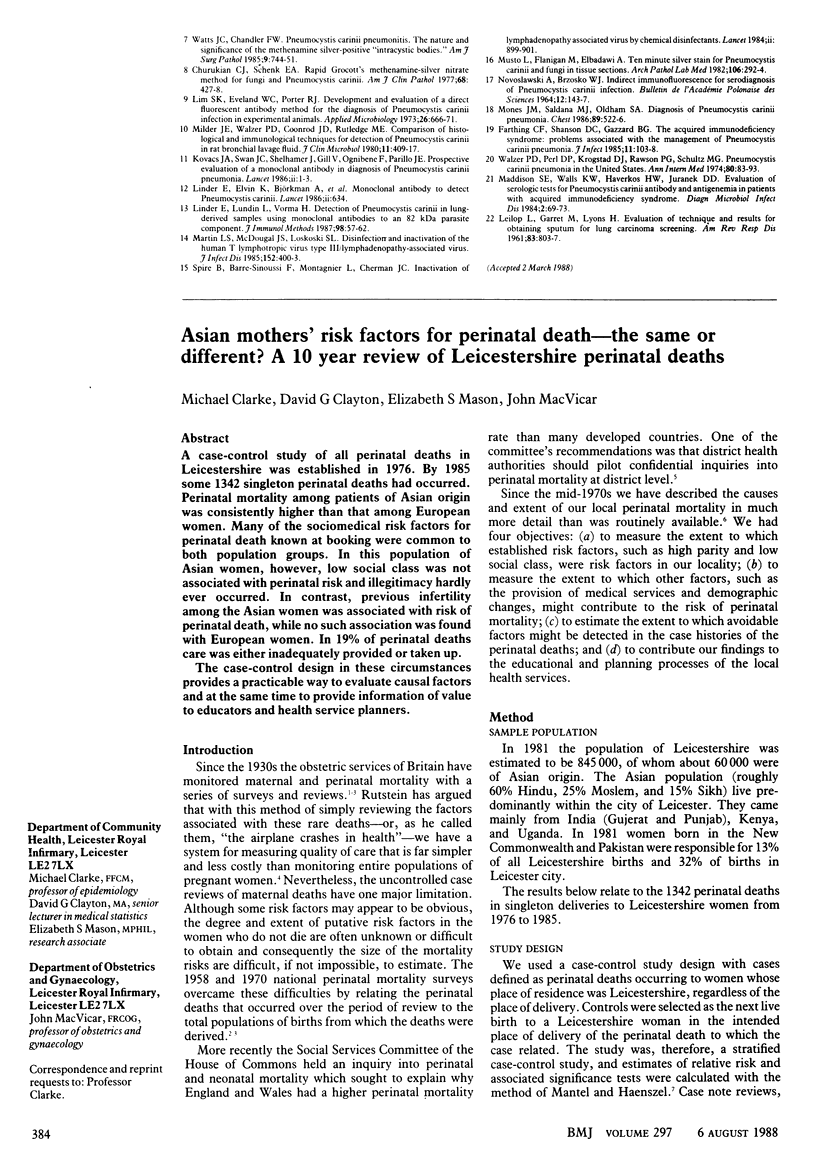Abstract
Diagnosis of pneumocystis pneumonia is based on identifying Pneumocystis carinii cytochemically in material from the lung. The silver methenamine staining methods most commonly used are technically difficult and lack specificity. The diagnostic value of immunocytological identification of the parasite was evaluated by using mouse monoclonal antibody 3F6, specific for human pneumocystis, to identify P carinii in bronchoalveolar lavage fluid and sputum by immunofluorescence and was compared with that of other variables. Bronchoalveolar lavage was performed on 25 patients positive for HIV antibody with clinically suspected pneumocystis pneumonia and 40 patients negative for HIV antibody who presented with interstitial disorders of the lung. Lavage fluid showed pneumocystis only in the patients positive for antibody, the parasite being detected in 19 by immunofluorescence and in 17 by a modified silver methenamine staining method. Chest x ray films obtained at the time of bronchoscopy showed interstitial or alveolar shadowing in 17 of the 19 patients, but clinical symptoms and the presence of antibodies to pneumocystis did not seem to be predictive. Sputum samples were collected during 43 episodes of clinically suspected pneumocystis pneumonia in patients positive for HIV antibody. Pneumocystis was detected consistently more commonly by immunofluorescence than the silver strain in sputum collected routinely and induced by inhalation of saline. In 17 patients bronchoalveolar lavage followed sputum collection, and the sensitivity of detection of pneumocystis in immunofluorescence in sputum compared with lavage fluid was 57% (8/14). Immunofluorescence was suitable for specimens fixed in ethanol and seemed highly specific and more sensitive than the standard cytochemical methods for identifying pneumocystis.
Full text
PDF



Images in this article
Selected References
These references are in PubMed. This may not be the complete list of references from this article.
- Bigby T. D., Margolskee D., Curtis J. L., Michael P. F., Sheppard D., Hadley W. K., Hopewell P. C. The usefulness of induced sputum in the diagnosis of Pneumocystis carinii pneumonia in patients with the acquired immunodeficiency syndrome. Am Rev Respir Dis. 1986 Apr;133(4):515–518. doi: 10.1164/arrd.1986.133.4.515. [DOI] [PubMed] [Google Scholar]
- Broaddus C., Dake M. D., Stulbarg M. S., Blumenfeld W., Hadley W. K., Golden J. A., Hopewell P. C. Bronchoalveolar lavage and transbronchial biopsy for the diagnosis of pulmonary infections in the acquired immunodeficiency syndrome. Ann Intern Med. 1985 Jun;102(6):747–752. doi: 10.7326/0003-4819-102-6-747. [DOI] [PubMed] [Google Scholar]
- Churukian C. J., Schenk E. A. Rapid Grocott's methenamine--silver nitrate method for fungi and Pneumocystis carinii. Am J Clin Pathol. 1977 Sep;68(3):427–428. doi: 10.1093/ajcp/68.3.427. [DOI] [PubMed] [Google Scholar]
- Dutz W., Burke B. A. Cytologic diagnosis of Pneumocystis carinii. Natl Cancer Inst Monogr. 1976 Oct;43:157–161. [PubMed] [Google Scholar]
- Farthing C. F., Shanson D. C., Gazzard B. G. The acquired immune deficiency syndrome: problems associated with the management of Pneumocystis carinii pneumonia. J Infect. 1985 Sep;11(2):103–108. doi: 10.1016/s0163-4453(85)91883-3. [DOI] [PubMed] [Google Scholar]
- Kovacs J. A., Gill V., Swan J. C., Ognibene F., Shelhamer J., Parrillo J. E., Masur H. Prospective evaluation of a monoclonal antibody in diagnosis of Pneumocystis carinii pneumonia. Lancet. 1986 Jul 5;2(8497):1–3. doi: 10.1016/s0140-6736(86)92555-9. [DOI] [PubMed] [Google Scholar]
- LEILOP L., GARRET M., LYONS H. A. Evaluation of technique and results for obtaining sputum for lung carcinoma screening. A study by blind technique. Am Rev Respir Dis. 1961 Jun;83:803–807. doi: 10.1164/arrd.1961.83.6.803. [DOI] [PubMed] [Google Scholar]
- Lim S. K., Eveland W. C., Porter R. J. Development and evaluation of a direct fluorescent antibody method for the diagnosis of Pneumocystis carinii infections in experimental animals. Appl Microbiol. 1973 Nov;26(5):666–671. doi: 10.1128/am.26.5.666-671.1973. [DOI] [PMC free article] [PubMed] [Google Scholar]
- Linder E., Elvin K., Bjorkman A., Bergdahl S., Morfeldt-Mansson L., Moberg L., Sonnerborg A. Monoclonal antibody to detect Pneumocystis carinii. Lancet. 1986 Sep 13;2(8507):634–634. doi: 10.1016/s0140-6736(86)92463-3. [DOI] [PubMed] [Google Scholar]
- Linder E., Lundin L., Vorma H. Detection of Pneumocystis carinii in lung-derived samples using monoclonal antibodies to an 82 kDa parasite component. J Immunol Methods. 1987 Apr 2;98(1):57–62. doi: 10.1016/0022-1759(87)90435-2. [DOI] [PubMed] [Google Scholar]
- Maddison S. E., Walls K. W., Haverkos H. W., Juranek D. D. Evaluation of serologic tests for Pneumocystis carinii antibody and antigenemia in patients with acquired immunodeficiency syndrome. Diagn Microbiol Infect Dis. 1984 Jan;2(1):69–73. doi: 10.1016/0732-8893(84)90025-7. [DOI] [PubMed] [Google Scholar]
- Martin L. S., McDougal J. S., Loskoski S. L. Disinfection and inactivation of the human T lymphotropic virus type III/Lymphadenopathy-associated virus. J Infect Dis. 1985 Aug;152(2):400–403. doi: 10.1093/infdis/152.2.400. [DOI] [PubMed] [Google Scholar]
- Milder J. E., Walzer P. D., Coonrod J. D., Rutledge M. E. Comparison of histological and immunological techniques for detection of Pneumocystis carinii in rat bronchial lavage fluid. J Clin Microbiol. 1980 Apr;11(4):409–417. doi: 10.1128/jcm.11.4.409-417.1980. [DOI] [PMC free article] [PubMed] [Google Scholar]
- Mones J. M., Saldana M. J., Oldham S. A. Diagnosis of Pneumocystis carinii pneumonia. Roentgenographic-pathologic correlates based on fiberoptic bronchoscopy specimens from patients with the acquired immunodeficiency syndrome. Chest. 1986 Apr;89(4):522–526. doi: 10.1378/chest.89.4.522. [DOI] [PubMed] [Google Scholar]
- Pitchenik A. E., Ganjei P., Torres A., Evans D. A., Rubin E., Baier H. Sputum examination for the diagnosis of Pneumocystis carinii pneumonia in the acquired immunodeficiency syndrome. Am Rev Respir Dis. 1986 Feb;133(2):226–229. doi: 10.1164/arrd.1986.133.2.226. [DOI] [PubMed] [Google Scholar]
- Rorat E., Garcia R. L., Skolom J. Diagnosis of Pneumocystis carinii pneumonia by cytologic examination of bronchial washings. JAMA. 1985 Oct 11;254(14):1950–1951. [PubMed] [Google Scholar]
- Spire B., Barré-Sinoussi F., Montagnier L., Chermann J. C. Inactivation of lymphadenopathy associated virus by chemical disinfectants. Lancet. 1984 Oct 20;2(8408):899–901. doi: 10.1016/s0140-6736(84)90657-3. [DOI] [PubMed] [Google Scholar]
- States B., Holtzapple P., Rosenhagen M., Segal S. Effect of hypothermic storage of kidney slices on membrane ATPases and electrolyte transport. Kidney Int. 1972 Jul;2(1):17–21. doi: 10.1038/ki.1972.65. [DOI] [PubMed] [Google Scholar]
- Walzer P. D., Perl D. P., Krogstad D. J., Rawson P. G., Schultz M. G. Pneumocystis carinii pneumonia in the United States. Epidemiologic, diagnostic, and clinical features. Ann Intern Med. 1974 Jan;80(1):83–93. doi: 10.7326/0003-4819-80-1-83. [DOI] [PubMed] [Google Scholar]
- Watts J. C., Chandler F. W. Pneumocystis carinii pneumonitis. The nature and diagnostic significance of the methenamine silver-positive "intracystic bodies". Am J Surg Pathol. 1985 Oct;9(10):744–751. [PubMed] [Google Scholar]



